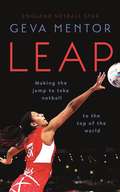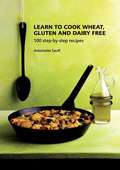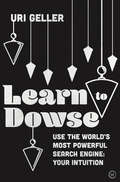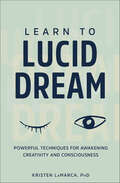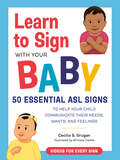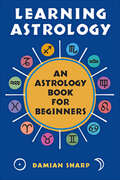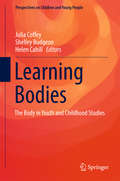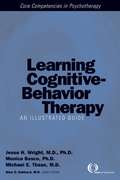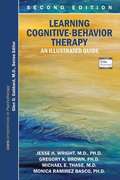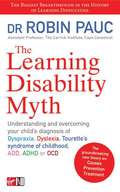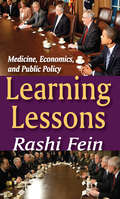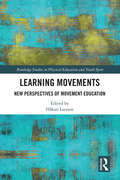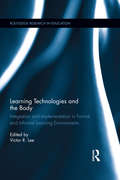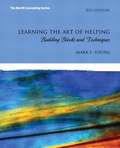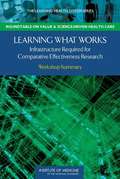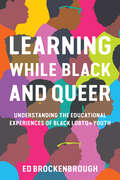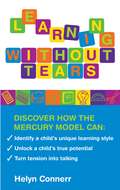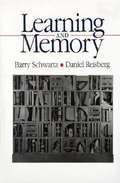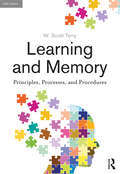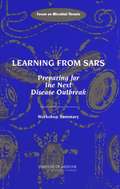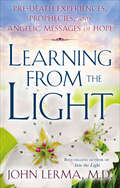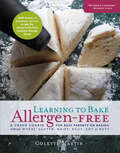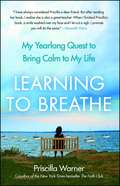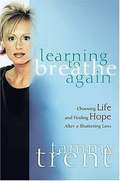- Table View
- List View
Leap: Making the jump to take netball to the top of the world
by Geva MentorAn inspiring memoir by England netball star and Commonwealth Games gold medallist Geva Mentor. **Includes an exclusive 15% discount code for Gilbert Netball**Geva Mentor is the best netballer in the world. In her honest, open and inspiring autobiography, Leap, she sheds light on her journey to the top.As a child Geva was a naturally gifted athlete, standing out at 5'10" at the age of twelve. She began life as a champion trampolinist, but when she outgrew the sport, literally, she found she had to try something new. This led her to basketball, but the boys on the other teams complained - she was just too good. Making up the numbers for an impromptu netball match one day at the age of thirteen she found her home in netball - or rather it found her.From here, Geva's rise amongst the ranks of British netball was stratospheric, she was playing for the England senior team when she was just fifteen years old. Taking risks and forging the way for other athletes Geva moved to Australia to develop her game by playing in the best league in the world and eventually winning Commonwealth gold with the England Roses. However, it's not all been easy, both on and off the court, and Geva talks honestly about her personal life, and how the difficulties and failures of her teams, both international and domestic, have driven her on to achieve the highest possible success in the sport.
Leap: Making the jump to take netball to the top of the world
by Geva MentorAn inspiring memoir by England netball star and Commonwealth Games gold medallist Geva Mentor. **Includes an exclusive 15% discount code for Gilbert Netball**Geva Mentor is the best netballer in the world. In her honest, open and inspiring autobiography, Leap, she sheds light on her journey to the top.As a child Geva was a naturally gifted athlete, standing out at 5'10" at the age of twelve. She began life as a champion trampolinist, but when she outgrew the sport, literally, she found she had to try something new. This led her to basketball, but the boys on the other teams complained - she was just too good. Making up the numbers for an impromptu netball match one day at the age of thirteen she found her home in netball - or rather it found her.From here, Geva's rise amongst the ranks of British netball was stratospheric, she was playing for the England senior team when she was just fifteen years old. Taking risks and forging the way for other athletes Geva moved to Australia to develop her game by playing in the best league in the world and eventually winning Commonwealth gold with the England Roses. However, it's not all been easy, both on and off the court, and Geva talks honestly about her personal life, and how the difficulties and failures of her teams, both international and domestic, have driven her on to achieve the highest possible success in the sport.
Learn to Cook Wheat, Gluten and Dairy Free: 100 Step-by-Step Recipies
by Antoinette SavillA simple, stress-free guide to preparing meals that meet your dietary needs—and are still tasty enough for the whole family. If you&’ve been told to follow a diet free of wheat, gluten, or dairy, cooking at home more often is a great idea, giving you much more control over what you eat. But you don&’t want to be stuck making meals for the family and separate dishes for yourself to ensure that you avoid triggering allergies or intolerances. This cookbook offers lots of options that can make everyone happy while also keeping you healthy. Designed for beginners as well as experienced cooks, these recipes draw from a variety of cuisines and use alternative ingredients such as coconut milk and rice flour. You&’ll find recipes to replace all those ready-made meals, snacks, and desserts you used to pick up in the supermarket—soups, sauces, lasagna, macaroni and cheese, fish pie, burgers, casseroles, muffins, cupcakes, Christmas cake, cheesecake, crumble, apple pie, sausage rolls, quiche, and more. As a bonus, there are also recipes for special occasions—from Christmas and birthdays to everyday entertaining.
Learn to Dowse: Use the World's Most Powerful Search Engine: Your Intuition
by Uri GellerBy celebrity psychic Uri Geller, this simple, fun and visually attractive guide explains how to improve your life by unlocking your intuition and learning this ancient but effective divinatory art.Dowsing simply means searching for something by intuition. It's widely regarded as being a psychic method of looking for water, but it's so much more than that – you can dowse for everything from lost objects to the self-knowledge hidden in your subconscious – and this book will show you exactly how. All of us have intuition but in this modern world we have become disconnected from this ancient power. Uri Geller is famous around the world for his intuitive, paranormal powers, which range from bending spoons to astounding feats of dowsing, such as his location of huge offshore oil field on behalf of Mexico's national oil company (for which he was rewarded with Mexican citizenship). In this amazing book, he guides you step by step through the hidden world of dowsing that he knows so well. Simple exercises in the form of Uri mini-class activities, and fun games such as crystal hide-and-seek, teach the basic skills you need to dowse, whether you use divining rods, a pendulum, a forked twig or just your hands. The book then explains how to use these skills to find everything from lost objects to water, fossils, archaeological remains and even hidden treasure! Most importantly, Uri reveals how dowsing can help you unlock submerged thoughts and knowledge and evaluate vital choices in business, love and family life. Also including real-life case studies of amazing dowsing events, stories of celebrity dowsers through history and background explanation of the science of dowsing, this is a super accessible and fun guide to the most useful of the paranormal skills.
Learn to Lucid Dream: Powerful Techniques for Awakening Creativity and Consciousness
by Kristen LaMarcaFollow your dreams and discover your best self—a beginner's guide.You're the stuff dreams are made of—or rather, your subconscious is. Learn to Lucid Dream teaches you how to deliberately explore and manipulate your dreams (called "lucid dreaming") to gain insight into your inner self. You might even learn to conquer your nightmares—or just enjoy the dreamy freedom of flying.This methodical introduction teaches you both the science and spirituality of dreaming. You'll practice developing dream awareness and apply the discoveries you make while sleeping towards improving your waking hours. Lucid dreaming can help you heighten your focus, prioritize your core values, and be more observant.This guide to lucid dreaming includes:Step-by-step plan—Follow each chapter's research-based lessons and techniques to develop and hone your lucid dreaming skills.Personal accounts—Hear the author's firsthand anecdotes of lucid dreaming—and the positive effects their lessons have had on her life.Dream sequence—Solidify your new skills in a 24-hour lucid dreaming practice sequence, including exercises for morning, daytime, bedtime, and nighttime.Learning the extraordinary art of lucid dreaming is easier than you think with the techniques in Learn to Lucid Dream.
Learn to Sign with Your Baby: 50 Essential ASL Signs to Help Your Child Communicate Their Needs, Wants, and Fe elings
by Cecilia S. GruganCommunicate, connect, and bond with your baby with 50 essential, easy-to-learn ASL signs.Your baby is crying. Are they hungry or are they tired? With 50 practical ASL signs that cover a child&’s day, Learn to Sign with Your Baby will help you better understand your child and help them communicate with you. Author Cecilia S. Grugan, a Deaf parent, gives you detailed instructions and tips for how to master each sign, as well as helpful advice and fun activities for incorporating ASL into your life with baby. And with clear illustrations and video demonstrations for each sign, you can confidently start signing with your baby—and watch as your bond deepens and strengthens.Learn to Sign with Your Baby includes: 50 of the most useful ASL signs. From &“more&” and &“eat&” to &“change&” and &“hurt,&” this book teaches the most relevant and practical terms for your daily life with baby—and makes signs for specific needs easy to find.Step-by-step color illustrations and video for every sign. The video for each sign can be accessed by a QR code; scan it for step-by-step guidance to confidently and correctly form each sign.Engaging activities make ASL fun. Play a game, sing a song—this book makes incorporating ASL into your life enjoyable and rewarding.Helpful tips. Tips for remembering the signs, how to effectively use them, and what to look for as baby signs back make ASL easy to learn and easy to use.
Learning Astrology: An Astrology Book for Beginners
by Damian Sharp“[Sharp] elegantly casts a web of astrological knowledge . . . as he explains the nuances of each aspect that influences the individual horoscope.” —Library Journal“Astrology is both a science and an art. It is a symbolic representation of all of the elements—religious, spiritual, emotional, mental and physical, visible and invisible—that exist in the universe and come together in various and diverse combinations to account for individual human beings and the forces that shape and act upon them.”While there are numerous astrology books available, many are decades old and require you to wade through a morass of technical details just to get to the basics. In Learning Astrology, Damian Sharp provides a fun, fresh approach to understanding this ancient art, making it easily accessible to those who are completely new to the subject and/or put off by older, more complicated books. In clear, concise language and an easy-to-follow order, he provides insight into sun signs and planets, houses and aspects and shows us how to actually read an astrological chart, simply and accurately. And if you want the more technical details, Sharp provides those, too. By the end of the book, you’ll be discussing conjunctions, sextiles, squares, and trines like a pro. Learn astrology from Damian Sharp and become your own astrologer.
Learning Bodies
by Julia Coffey Shelley Budgeon Helen Cahill'Learning Bodies' addresses the lack of attention paid to the body in youth and childhood studies. Whilst a significant range of work on this area has explored gender, class, race and ethnicity, and sexualities - all of which have bodily dimensions - the body is generally studied indirectly, rather than being the central focus. This collection of papers brings together a scholarly range of international, interdisciplinary work on youth, with a specific focus on the body. The authors engage with conceptual, empirical and pedagogical approaches which counteract perspectives that view young people's bodies primarily as 'problems' to be managed, or as sites of risk or deviance. The authors demonstrate that a focus on the body allows us to explore a range of additional dimensions in seeking to understand the experiences of young people. The research is situated across a range of sites in Australia, North America, Britain, Canada, Asia and Africa, drawing on a range of disciplines including sociology, education and cultural studies in the process. This collection aims to demonstrate - theoretically, empirically and pedagogically - the implications that emerge from a reframed approach to understanding children and youth by focusing on the body and embodiment.
Learning Cognitive-Behavior Therapy: An Illustrated Guide
by Michael E. Thase Jesse H. Wright Monica R. BascoLearning Cognitive-Behavior Therapy: An Illustrated Guide is designed to help both students and practitioners master the core methods of this proven form of psychotherapy. This easy-to-use guidebook offers full explanations of the most effective behavioral methods; a program designed for achieving competency that covers both basic methods for patients with depression and anxiety and advanced techniques for patients with bipolar disorder, psychoses, and eating and personality disorders; an integrated cognitive-behavioral/biological/interpersonal model for treatment; and instructions on fully integrating CBT with psychopharmacological intervention, as well as formulation and treatment methods endorsed by the Academy of Cognitive Therapy.
Learning Cognitive-Behavior Therapy: An Illustrated Guide (Core Competencies in Phychotherapy Ser.)
by Glen O. Gabbard Michael E. Thase Jesse H. Wright Monica Ramirez Basco Gregory K. BrownBuilding on its successful -read-see-do- approach, this second edition of Learning Cognitive-Behavioral Therapy: An Illustrated Guide seamlessly combines 23 all-new videos with informative text and figures, charts, worksheets, checklists, and tables to help readers not only learn the essential skills of CBT but achieve competence in this important evidence-based treatment method. <P><P>Opening with an overview of core cognitive-behavior therapy (CBT) theories and techniques, leading CBT practitioners then describe and demonstrate how to build effective therapeutic relationships with CBT, conceptualize a case with the CBT model, structure sessions, and resolve common problems encountered in CBT. <P><P>This updated, second edition of the best-selling and highly popular Learning Cognitive-Behavioral Therapy also features: - Ways to employ CBT to reduce suicide risk- Guidance on integrating therapies related to CBT -- including dialectical behavior therapy, mindfulness-based cognitive therapy, and well-being therapy -- in the context of personality disorders and chronic or recurrent depression- An appendix of curated resources by the expert authors -- recommended readings, computer programs, Web sites, videos, and organizations -- to give readers access to the best resources in building competence in CBT practice <P><P>The all-new videos feature clinicians demonstrating methods in real-world settings and include new topics such as safety planning and uncovering and changing maladaptive schemas. Proven as one of the best teaching tools for building competence in CBT, this new edition will enrich readers' understanding and practice of CBT.
Learning Disability Myth
by Robin PaucDr. Robin Pauc argues that children diagnosed with dyspraxia, dyslexia, ADD, ADHD, OCD and Tourette's syndrome essentially come from a development path known as apoptosis. Pauc provides help with treating syndromes and guides parents to work with their doctors to help their children.
Learning Lessons: Medicine, Economics, and Public Policy
by Rashi FeinThis is a book about the policy process. It discusses the considerations advisers have in mind as they develop and select policy alternatives, the ways each of us might want to think about making decisions, and the lessons we should remember in order to minimize avoidable errors. In writing about his experiences in government, the classroom, and private life, Fein offers insights that apply to people responsible for decisions in many kinds of institutions, at all levels of responsibility.His anecdotes and the situations he describes are drawn from over fifty years of experience in the policy arena. They are not intended to represent either a rounded theory about public administration or a comprehensive treatment of important components of political science. Like most people in the policy arena, Fein came to that work from another discipline-in his case economics. His experience of finding his own way through action and experience rather than through application of theory might appear quaint. But his successes, failures, and the lessons he learned, illuminate the process and may prove useful, even inspirational.Fein is sensitive to the need to move beyond statistics and to present the real world and the faces of real people behind the data. He believes that an effective adviser should bring knowledge and interests that extend beyond the confines of a single discipline, even one as methodologically powerful as economics. Unless the adviser presents a range of choices that have been developed with contributions from many fields of knowledge, the proposed policies are likely to be far too constrained and, at worst, unworkable. His perspective, articulated in this book, is easily summarized: there is more to life and to our nation's welfare than economics. We live in a society, not in an economy.
Learning Movements: New Perspectives of Movement Education (Routledge Studies in Physical Education and Youth Sport)
by Håkan LarssonContemporary ways of understanding human movements, specifically movement learning, are heavily dominated by individualistic, dualistic and mechanistic perspectives. These perspectives are individualistic in the sense that in research as well as in educational practice movements/movers are typically decontextualized, they are dualistic in the sense that the body is taken to be ‘inhabited’, even ‘governed,’ by a rational mind which is not itself a part of that body; and they are mechanistic in the sense that movements and movement learning can be ‘calculated’. This approach has supported the dominance of a westernised and predominantly white, masculinised and heteronormative view of able bodies, embodiment and movements. Hence, it has contributed to marginalise not only other approaches and perspectives and individuals. New research has evolved, including new approaches and these held perspectives have been challenged by social and culturally sensitive, holistic as well as pluralistic, and dynamic/organic perspectives of human movements and moving humans. Examples of such research can be found in disciplines such as; physical education and pedagogy, ethnography, philosophy, and sociology. Learning Movements: New Perspectives of Movement Education provides the societal and epistemological background for these new approaches and will be essential in disseminating this knowledge to movement educators, academics and researchers as well as professionals within education, sports, health and fitness, dance, outdoor activities, etc., and that it will spearhead new and inclusive practices within these settings.
Learning Technologies and the Body: Integration and Implementation In Formal and Informal Learning Environments (Routledge Research in Education #135)
by Victor R. LeeThis volume explores how technology-supported learning environments can incorporate physical activity and interactive experiences in formal education. It presents cutting-edge research and design work on a new generation of "body-centric" technologies such as wearable body sensors, GPS tracking devices, interactive display surfaces, video game controller devices, and humanlike avatars. Contributors discuss how and why each of these technologies can be used in service of learning within K-12 classrooms and at home, in museums and online. Citing examples of empirical evidence and specific implementation, this timely and critical volume examines how body responsive technologies are being used within the educational community to advance the next generation of educational technology.
Learning The Art of Helping: Building Blocks and Techniques (5th Edition)
by Mark E. YoungThis best-selling resource is a great refresher and hands-on resource for counselors new to their professions. It's packed with step-by-step guidance for developing the skills and techniques they need to effectively help their clients. It covers not just the basic building blocks in the profession, but also what the author calls the "megaskills" and common curative factors that lie behind the methods. The tone is conversational and the references are very useful.
Learning What Works: Workshop Summary
by J. Michael Mcginnis Leighanne Olsen Claudia GrossmanThis collection of essays, drawn from the Institute of Medicine's Round Table on Value and Science-Driven Health Care, presents current scholarship in the development of infrastructure and methodologies for improving health system frameworks in the coming decades. Topics discussed include infrastructure; training and personnel; advanced technologies and communications; and policy, priories and implementations of a value driven agenda. Contributors are executive level health policy professionals. Annotation ©2012 Book News, Inc. , Portland, OR (booknews. com)
Learning While Black and Queer: Understanding the Educational Experiences of Black LGBTQ+ Youth
by Ed BrockenbroughResearch-based guidance for educators, teacher educators, and community learning partners to effectively support LGBTQ+ students of color
Learning Without Tears
by Helyn ConnerrA collection of gluten-free and dairy-free recipes, showing how you can avoid these ingredients while enjoying healthy food. This book contains 200 recipes, including: soups, salads, fish, vegetarian dishes and others. It provides information on the differences between classical allergy and intolerance, and diagnosis and treatment of allergies.
Learning and Memory 1st Edition
by Barry Schwartz Daniel ReisbergThis book illustrates how various topics in learning and memory are related.
Learning and Memory: Basic Principles, Processes, and Procedures (Fifth Edition)
by W. Scott Terry<p>This thoroughly updated edition provides a balanced review of the core methods and the latest research on animal learning and human memory. The relevance of basic principles is highlighted throughout via everyday examples to ignite student interest, along with more traditional examples from human and animal laboratory studies. Individual differences in age, gender, learning style, cultural background, or special abilities (such as the math gifted) are highlighted within each chapter to help students see how the principles may be generalized to other subject populations. <p>The basic processes of learning – such as classical and instrumental conditioning and encoding and storage in long-term memory in addition to implicit memory, spatial learning, and remembering in the world outside the laboratory – are reviewed. The general rules of learning are described along with the exceptions, limitations, and best applications of these rules. The relationship between the fields of neuropsychology and learning and memory is stressed throughout. <p>The relevance of this research to other disciplines is reflected in the tone of the writing and is demonstrated through a variety of examples from education, neuropsychology, rehabilitation, psychiatry, nursing and medicine, I/O and consumer psychology, and animal behavior. <p>Each chapter begins with an outline and concludes with a detailed summary. A website for instructors and students accompanies the book. Updated throughout with new research findings and examples the new edition features: <p> <li>A streamlined presentation for today’s busy students. As in the past, the author supports each concept with a research example and real-life application, but the duplicate example or application now appears on the website so instructors can use the additional material to illustrate the concepts in class. <li>Expanded coverage of neuroscience that reflects the current research of the field including aversive conditioning (Ch. 5) and animal working memory (Ch. 8). <li>More examples of research on student learning that use the same variables discussed in the chapter, but applies them in a classroom or student’s study environment. This includes research that applies encoding techniques to student learning, for example: studying: recommendations from experts (Ch. 1); the benefits of testing (Ch. 9); and Joshua Foer’s Moonwalking with Einstein, on his quest to become a memory expert (Ch. 6). <li>More coverage of unconscious learning and knowledge (Ch. 11). <li>Increased coverage of reinforcement and addiction (Ch. 4), causal and language learning (Ch. 6), working memory (WM) and the effects of training on WM, and the comparative evolution of WM in different species (Ch. 8), and genetics and learning (Ch. 12).</li>
Learning from SARS: Preparing for the Next Disease Outbreak
by Forum on Microbial ThreatsThe emergence of severe acute respiratory syndrome (SARS) in late 2002 and 2003 challenged the global public health community to confront a novel epidemic that spread rapidly from its origins in southern China until it had reached more than 25 other countries within a matter of months. In addition to the number of patients infected with the SARS virus, the disease had profound economic and political repercussions in many of the affected regions. Recent reports of isolated new SARS cases and a fear that the disease could reemerge and spread have put public health officials on high alert for any indications of possible new outbreaks. This report examines the response to SARS by public health systems in individual countries, the biology of the SARS coronavirus and related coronaviruses in animals, the economic and political fallout of the SARS epidemic, quarantine law and other public health measures that apply to combating infectious diseases, and the role of international organizations and scientific cooperation in halting the spread of SARS. The report provides an illuminating survey of findings from the epidemic, along with an assessment of what might be needed in order to contain any future outbreaks of SARS or other emerging infections.
Learning from the Light: Pre-Death Experiences, Prophecies, and Angelic Messages of Hope
by John LermaA hospice doctor shares stories from his patients and their loved ones about transitioning to the next world and lessons we can learn from them.John Lerma’s bestselling book, Into the Light, inspired thousands of readers to discover not only what awaits us as we prepare to make our journey from earth to heaven, but, more importantly, how to achieve heaven on earth. Now in Learning from the Light, Dr. Lerma shares more angelic messages given to his patients and more stories from and about survivors who have experienced the loss of a loved one . . . and their visits with angels.The mystical experiences described in this revelatory work include:Messages about the future of the worldLessons on how to prepare for a peaceful and joyful transition to the next worldSelfless suffering and its effect on humanityElectronic voice phenomena (EVP)Interactions with white angels and dark angelsBased on the latest research on near-death and pre-death experiences, Learning from the Light will show you:How to achieve heaven on earthHow to achieve self-forgiveness and self-loveHow to disconnect from your ego to awaken your spiritual selfReligious skeptics often claim that heaven’s existence cannot be proven, because no one has ever returned to talk about it firsthand. This is the book that proves them wrong.Praise for Learning from the Light“With beautifully heartfelt sensitivity, Dr. John Lerma brings the truest accounts of life beyond death and the freedom that accompanies the dying process. No one can read this book without experiencing a smile, a tear, or embracing the possibility . . . no the reality that death is not an end but a reunion with our truest nature.” —Meg Blackburn Losey, PhD, author of the international bestseller The Children of Now“After journeying through three near-death experiences of my own, I can validate what Dr. Lerma has learned from his patients, in the process of transition. I highly recommend this book to everyone who wonders if there is life after death.” —Dannion Brinkley, author of Saved by the Light, At Peace in the Light, and Secrets of the Light
Learning to Bake Allergen-Free: A Crash Course For Busy Parents On Baking Without Wheat, Gluten, Dairy, Eggs, Soy Or Nuts
by Colette MartinA crash course for busy parents on baking without wheat, gluten, dairy, eggs, soy, or nuts Has your child been diagnosed with food allergies? If so, help is here! Colette Martin has been there too: When her son Patrick was diagnosed with multiple food allergies in 2001, she had to learn all-new ways to feed him—and especially to make baked goods that he both could and would eat. Learning to Bake Allergen-Free is the book Colette Martin wishes she had back then. She ingeniously presents a dozen manageable lessons that will arm parents to prepare allergen-free baked goods the entire family can enjoy together. The book features: • More than 70 recipes (including variations) sure to become family staples—for muffins, rolls, breads, cookies, bars, scones, cakes, tarts, pizza, and pies— starting with the easiest techniques and adding new skills along the way • Clear explanations of the most common allergens and gluten, with all the details you need on which substitutions work, and why • Hundreds of simple tips for adapting recipes and troubleshooting as you go • Detailed guidelines and more than 15 recipes for making allergen-free treats from packaged gluten-free baking mixes • Special crash courses focused on key ingredients and techniques, including sweetening options, decorating a cake simply but superbly, kicking everyday recipes up a notch, and much more! Whether you already love to bake or are a kitchen novice, Learning to Bake Allergen-Free will give you the knowledge, skills, recipes, and confidence to make food that your family can safely eat—and that they’ll love!
Learning to Breathe
by Priscilla WarnerPriscilla Warner has had a great life: a supportive husband, a flourishing marriage, two loving sons, and a bestselling book, The Faith Club. Despite all her good fortune and success, she suffers from anxiety and panic attacks so debilitating that they leave her unable to breathe. She's tried self-medicating--in high school, with a hidden flask of vodka--and later, with prescription medications--daily doses of Klonopin with a dark-chocolate chaser. After forty years of hyperventilating, and an overwhelming panic attack that's the ultimate wake-up call, Warner's mantra becomes "Neurotic, Heal Thyself." A spirited New Yorker, she sets out to find her inner Tibetan monk by meditating every day, aiming to rewire her brain and her body and mend her frayed nerves. On this winding path from panic to peace, with its hairpin emotional curves and breathtaking drops, she also delves into a wide range of spiritual and alternative health practices, some serious and some . . . not so much. Warner tries spiritual chanting, meditative painting, immersion in a Jewish ritual bath, and quasi-hallucinogenic Ayurvedic oil treatments. She encounters mystical rabbis who teach her Kabbalistic lessons, attends silent retreats with compassionate Buddhist mentors, and gains insights from the spiritual leaders, healers, and therapists she meets. Meditating in malls instead of monasteries, Warner becomes a monk in a minivan and calms down long enough to examine her colorful, sometimes frightening family history in a new light, ultimately making peace with her past. And she receives corroboration that she's healing from a neuroscientist who scans her brain for signs of progress and change. Written with lively wit and humor, Learning to Breathe is a serious attempt to heal from a painful condition. It's also a life raft of compassion and hope for people similarly adrift or secretly fearful, as well as an entertaining and inspiring guidebook for anyone facing daily challenges large and small, anyone who is also longing for a sense of peace, self-acceptance, and understanding.
Learning to Breathe Again: Choosing life and Finding Hope After a Shattering Loss
by Tammy TrentThis is the story of one young woman who copes with the devastating loss of her best friend and husband. She points to our true help, Jesus Christ.
